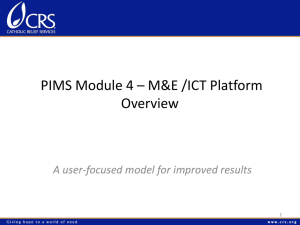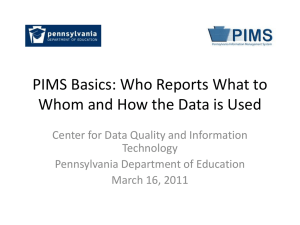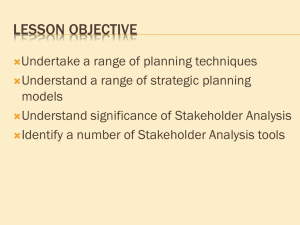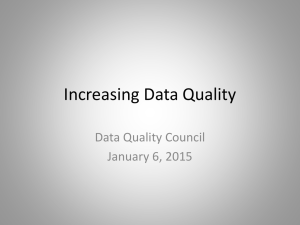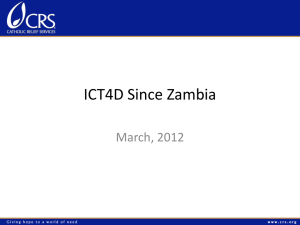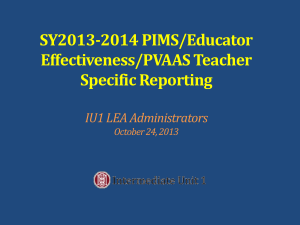example - Malik Management
advertisement
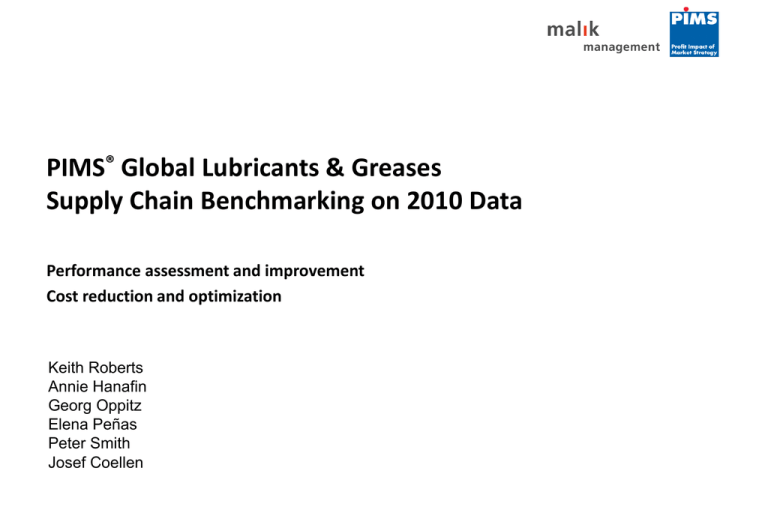
PIMS® Global Lubricants & Greases Supply Chain Benchmarking on 2010 Data Performance assessment and improvement Cost reduction and optimization Keith Roberts Annie Hanafin Georg Oppitz Elena Peñas Peter Smith Josef Coellen Introduction to the project and its motivation Lubricants manufacturers worldwide face many challenges. Economic uncertainty, high material costs, ecological concerns and increasing competitive pressure are forcing them to re-examine all areas of operations. Minimum cost and maximum flexibility are needed to address new market realities. Historically, there was pressure to increase market share, capacity and complexity: • in regions where demand for many lubricants is falling, due to lengthened vehicle service intervals and higher oil prices, companies are now having to make tough decisions on plant and product rationalisation. • in regions where demand for lubricants is rising due to increasing economic development, companies are having to achieve the operational edge necessary to build competitive advantage for market share growth and optimal capacity and complexity management. Over the last 18 years PIMS® has established its data-driven worldwide benchmarking process and assembled the world’s only current database of lubricants and greases supply chains. Leading companies use PIMS as the foundation for evidence based performance improvement. 2 But why benchmark in the first place? Because benchmarking gives you: • • objective evidence of your true competitive position; • quantified and prioritised areas of improvement: how much of an improvement is needed and what is the prize? (NB average $500,000 per plant in 2008); • better information systems: benchmarking makes it worthwhile to measure things because it gives a valid comparison on each metric used; • • a stimulus for change based on clear evidence versus real competitors; • • better understanding of the key drivers of performance; firm facts to base decisions on, rather than wishful thinking: this helps to avoid wrong competitive moves; the reassurance to everybody, where “hard change” is indicated, that the change is really necessary; a basis for analysing alternative future scenarios using real experiences of others who have been there. 3 And why PIMS? Because for more than 18 years we have provided lubes and greases manufacturers with fast, effective and objective benchmarking, becoming trusted advisors, known for thorough data collection and validation, good analysis and useful answers. Because you can use PIMS deliverables to answer questions like: • what should you do to get your operations to be world class? (process optimization) • what are your advantages / disadvantages versus local competitors? • where and how should you invest? Or divest? (portfolio optimization) • toll-blending, outsourcing, maintenance: yes or not, too much or too little? • how do you master performance and complexity drivers? • are your targets feasible? Is your current strategy supported by objective evidence? Because only PIMS has valid comparative data on over 160 plants in 40 countries, from over 20 of the world’s top oil companies, and a research-based analysis framework to clearly show results to managers at all levels. Because we assure data confidentiality: feedback never shows (or allows calculation of) data on individual competitors. 4 Our data set: 199 lube + 50 grease plants in 2010 PIMS benchmarking Europe: 67 lube plants 20 grease plants 34 companies 6 continents Americas: 51 lube plants 17 grease plants Asia & Oceania: 65 lube plants 10 grease plants Africa: 16 lube plants 3 grease plants Core methodologies: Look-alikes We compare you against the performance of the best plants that resemble your plant’s profile. Look-alikes are the closest structural peers: based on your current profile (scale, product mix, complexity, labour cost environment and major "givens" for configuration, e.g. % of base oil in via pipe etc.). We match you with your peers in each activity area, and compare you with the best half (e.g. best four out of eight). Details of the matching criteria are shown on the summary page for each activity area. Key messages on productivity and operating performance. C PIMS global database Finding plants worldwide that match your profile Benchmarking your activity based performance against best practice 6 Core methodologies: local low cost peers We compare you with the best half of your closest geographical/market peers in each activity area (raw material receipt, blending, packing, laboratory, filling and despatch, warehousing, other production costs and assets, G&A, etc.). What are they doing differently and are they doing better? Key messages on complexity, product portfolio, payroll costs, structure etc. Cost metric Non-cost metric You Local low cost Traffic-light code: 1.25 Unfavourable position Neutral position 0.8 Favourable position No immediate message PIMS can amend the default definitions and boundaries of “local” areas to meet clients needs, so long as the number of “local” observations in the database can guarantee 100% confidentiality. 7 PIMS deliverables Results comprise three different level of benchmarking reports: • • • The plant data appendix (PDA) is for plant and country managers. It is the place where one plant’s performance is assessed and compared in great detail against its best lookalikes and local low cost peers. The regional report is for regional managers. It shows all plants in a region (e.g. Europe) benchmarked against each other and regional quartiles. It also tracks the plants and the regional quartiles over time. It is the first report presented to the client as it is used in the data review stage to spot possible mistakes in inputs. The Executive Summary is the final report, where all the key issues arising from the more detailed reports are highlighted and reviewed from a different perspective. This reports also provides PIMS suggestions and priorities (ranked by financial “prize”). Executive Summary Low Regional Report (Quartiles & Time Series) Level of detail Plant Data Appendix Hi 8 The input Data Form PIMS Lube/Grease Plant Benchmarking Company Page 1 Year of data Volume unit Country Plant Distance unit Currency PIMS Lube/Grease Plant Benchmarking Country Page 2 Plant raw material receipt (including bulk finished product) Into plant: Base oil Bulk additives Packed additives Bulk fin. product Total no. different types of test Total no. tests per equipment year Base oil handling points between refinery and LOBP: Total Volume inbound (1=pipe/2=ship/3=barge/4=rail/5=road) Input cost* *Row optional No. storage tanks By mode: Volume out Mode in Mode out No. stockouts Av. distance Transport cost No. movements Line items/mvmt. Av. days stock No. specs. Days lead time No. active quality certifications % of batches: 1 = yes (or equiv.); 0.5 = part % of tests (row sum =100%) by process stage Material receipt In-process contr Product release Post production % corrections TS 16949? OSHA 18001? 7 Bulk filling and despatch (including base oil and other bulk) Pipe Bulk ship Out by: Bulk barge Bulk barge Capacity utilization % Bulk rail Bulk rail % orders despatched OTIF Bulk road Bulk road Line items /mvt. Packed Packs & pack materials Lubricant blending Including pre- and re-blends: Number of runs Volume blended Total Number of units <11M3 (3000 gal) Manual Semi-auto Overall line-hours Automatic Available Setup+maintce Blending In-line Load cell Tank blends Total blended By order: Volume as % of capacity Toll % To order % Marine Hydraulic Bulk Own VI improver pre-blends as % of VII usage Excluding pre- and re-blends: Packed Motor oil Gear oil Finished product tank stocks: For stock % Total 100% Days stock Total 100% No. storage tanks Ind./other simple Ind./oth. complex Blended non-lubes Total Volume lubricant produced No. grades No. grades = 80% of prodn. No. new formulations this year No. finished product runs Av. no. components Typical cycle time (hours) Lubricant packing Large packs (IBCs, drums, kegs, pails) Small packs (up to 10 litres, 2.5 gallons) Large packs No. lines Large pack overall line-hours Person-hours Small packs Small pack overall line-hours Available Setup+maintce Filling No. lines Person-hours Available Setup+maintce Filling IBCs Drums Kegs Pails 3 to 10 litre 1 or 2 litre <1 litre Total Manual Semi-auto Automatic By pack type: Volume packed (in house) Volume packed (outsourced) No. runs No. SKUs No. pack footprints Grease production and packing Equipment: No. lines (units) Total personhours Volume unit Overall line-hours No. batches No. flushings Available Setup+maintce Production Cooling Continuous line Autoclaves + contactors % batches special greases Preparation vessels Finishing kettles Mills + homogenizers Finished grease tank stocks: Packing: Days stock Small packs No. storage tanks Thickener type: >10 kg. packs Al complex Ca soap Volume packed Ca complex No. lines Li soap Person-hours Li complex Line-hours Other soap No. runs Polyurea No. pack footpr. Clay No. SKUs All other Volume grease made No. production runs No. grades No. colours Av. no. components Av. hours/batch ISO 14000? % reject Lubes Greases Volume moved Plant Laboratory (lubes and greases production related) The electronic version of the PIMS data form also provides a diagnostic sheet to help clients spot possible macroscopic mistakes and a cost split sheet to explain how the costs are split during the analysis according to the allocation keys provided. Volume lubes Volume greases Volume other Automation (0=no, 0.5=management, 1=operation) No. filling positions No. movements No. SKUs Av. days stock Volume out % cust. collect % exports Area unit (m2 or ft2) Plant warehousing and loading / unloading (packed products) Packed: No. bulk orders Packed inbound product Volume in Lubes Packed warehouse: Automation (0=no, 0.5=management, 1=operation) Greases % product refilled/relabelled Other No. movements out Total No. movements in Total Warehouse capacity: No. orders % orders OTIF % cust. collect Line items /mvt. Shelf Block inside % volume out: 1-product pallets Block outside Area of storage For customer No. pallet places Other % exports Split pallets Containers Free loaded Losses in plant + warehouse Lubes: Value lost Greases: Volume Value lost Volume Empty packs: % Stock count losses Stock count losses Recovered downgrades Recovered downgrades % value lost Cost per 100 drums Slops Slops Cost per 100 1 litre (quart) packs Pack cost data General data on energy, systems, maintenance planning, health, environment, safety etc. Days/year plant operated Energy use: Units Volume Control systems: 1 = yes; 0.5 = part Cost Steam Automated production scheduling Gas Adapt to weekly sales forecast Electricity Other (specify type) HES: Activity based costing Fuel oil Maintenance % that is Mandated Volume Number Spills Other environmental incidents Lost-time accidents Other planned First-aid injuries Reactive total 100% Overall plant breakdown of costs, people, assets Split of people and costs by area: No. people Operations Maintenance People cost Operations Maintenance Person-hours Standard Non-people cash cost Overtime Operations Maintenance Outsourced Bulk raw materials in Pack raw materials in Lubricants blending Lubricants large packs Lubricants small packs Greases prodn & packing Laboratory Bulk filling Warehouse General & administrative Total . . of which Management Energy (as above) + utilities Direct employees Rents, tax, permits Contractors and temps Split of G&A in-plant Cost in plant Gen activity vs services shared & admin row 124 from HQ: cells E+I+K Allocated cost from HQ Operations Security + safety Maintenance Office Outsourced Accounting Other Personnel Owned fixed assets and depreciation: Data processing Procurement Gross book value Production planning Lube plant Engineering Grease plant HES/security/legal Warehouse General Notes Total % of non-people cash cost that is HQ-determined price Transport Net book value 3-year average capex / year Leased fixed assets: Annual depreciation Calc. gross book value Annual lease cost Total Plant opex = E125+F125+I125+J125+K125+I138+K138 (excludes freight in, losses, allocated cost) Notes ©2009 PIMS Europe Ltd.15 Basinghall Street London EC2V 5BR +44 20 7776 2800 (fax 2828) Email: lubes@pimsconsulting.com Version 1.4 ©2009 PIMS Europe Ltd. +44 20 7776 2800 (fax 2828) lubes@pimsconsulting.com Person-hours to fill this form Version 1.4 9 Potential additional benchmarks for 2010 Order to despatch time in days (agile production), split between bulk, large packs, small packs, greases, etc.. Need to split produced to order versus delivered from stock. Suggest capturing the minimum, average of lowest 80%, average of top 20%, and on time in full despatch performance (on a line item basis?). Organization structure in global/regional/national offices of multi-plant companies. In particular, how many people are involved in planning and deciding what to produce where for which customer and ensuring the necessary resources and materials are in place? What key performance indicators are used by the oil companies and their transport companies in distribution to customers? From the transport companies, how do lubricants compare to other products? (Suggested focus on 12 countries or so: USA, Canada, Mexico, Brazil, Germany, France, Italy, UK, Spain, Poland, Turkey, China). 10 Regional report: bar chart examples Plant summary - total volumes & no. grades by product type Company X Region 1 2008 Volume 350000 No. grades 300 Grease Non-lubes Industrial/other complex 300000 Industrial/other simple 250 Hydraulic oil Marine oil 200 Gear oil Motor oil 200000 150 No. of grades Plant summary - total packed product volumes & SKUs by pack type 150000 Company X Region 1 2008 Volume 120000 100 100000 No. SKUs Grease small 800 Grease large < 1 litre 100000 50 50000 Region 1 Compan av y X av Volume and stock keeping units are plotted in bar charts, plant by plant and against region and company averages. The split between different pack volumes together with the SKU/volume ratio give an immediate feeling of the warehouse tasks, complexity and competitive position within the region. Total volume tons 3-10 litres 0 700 1-2 litres 600 Pails 80000 0 Kegs 500 Drums IBCs 60000 400 No. of SKUs Total volume tons 250000 Volume and grades are plotted in bar charts, plant by plant and against region and company averages. The split between different lubricants, non-lubes and grease together with the grades/volume ratio give an immediate feeling of plants structure,, complexity, mission and regional competitive position. 300 40000 200 20000 100 0 0 Region 1 Compan avg y X avg 11 The regional report also shows time series of costs, complexity and productivity 12 Regional report: table-bubble chart examples PIMS shows your cost and performance position relative to your competitors in the agreed region boundaries. Is there room for improvement? If so, where do you have the highest potential to reduce costs? 13 Regional report: quartiles-table examples Key performance indicators are shown against adhoc regional percentiles while traffic light colour coding is employed to highlight clear performance gaps against regional competitors. A number of tables like the one in the example are reported in the RDA to cover all activity areas and cost centres. 14 The plant data appendix (PDA) Within the PDA each plant is benchmarked individually against the best look-alikes and local low cost peers and the report is specifically designed to: • • • • • • highlight any possible performance gap at plant level in areas like raw material receipt, lubricants blending and packing, grease production and packing, bulk filling and despatch, plant warehouse, losses, G&A, overall heads, assets, maintenance and utilities costs. show ad-hoc time series to analyze and highlight volume, costs and productivity changes for those plants who regularly participate in the PIMS benchmarking project. illustrate and explain the clients what are the complexity drivers in each activity area and their computed weight and impact on the relative complexity index. explain the cost split between the lubes, greases, warehouse and non-lubes related activities by area decompose, with the help of waterfall-graphs and specific support tables, the overall costs into both financial and non-financial metrics, which are promptly benchmarked against look-alikes and local low cost peers at each level of PIMS decomposition. use a traffic light colour coding to highlight the competitive position against peers. Finally, a summary list of issues (performance gaps) flagged by the whole report is shown, highlighting the PIMS top six priorities based on those areas with the greatest financial “prize”. 15 PDA: priority areas against look-alikes and local low cost peers Cost and non-cost metrics are here benchmarked against look-alikes and local low cost peers, by activity area, taking into account the typical decomposition from total cost production to operating cash cost, non operating cash costs and depreciation plus lease costs. The PIMS top 6 areas are also highlighted by the greatest potential return computed from actual performance gaps . 16 PDA: data summaries with complexity drivers and cost split explained PIMS defines complexity as those factors that are intrinsic to the plant’s mission: controllable in the medium term, but fixed in the short term. The scale is 50% = average, over 60% = high, below 40% = low. As complexity is the driver of manning levels and productivity, it is also the key driver of costs in medium to high labour cost countries. Please note: The PIMS complexity index is volume corrected: high volume plants often have “lower” PIMS complexity, but also lower cost/ton. 17 PDA: your performance against look-alikes and local low cost peers PIMS shows your cost and performance position relative to your closest competitors (in your local area) and to structurally similar “look-alikes” Is there room for improvement? If so, where do you have the highest potential to reduce costs? To answer these questions, PIMS provides you with detailed analysis across plant activity areas… 18 PDA: quality of look-alike matching explained PIMS finds plant areas from the database, that are structurally similar to you (look-alikes). Matching criteria are clearly stated and the quality of the match is also displayed. Transparency despite confidentiality is the goal. 19 PDA: support tables Not all metrics analyzed and computed can be decomposed and included in a single waterfall-graph given the activity area. To support the study of performance gaps, waterfalls are followed by in-depth tables that show the benchmarks for both cost and noncost metrics that are key performance indicators for a given activity. 20 PDA: performance gaps and PIMS top 6 priorities PIMS provides you with areas for improvement by activity area. These include benchmarks on: • Payroll cost per head • Maintenance costs and other overhead costs • Complexity • Stock levels 21 The executive summary The Executive Summary is the final report, where all the key issues arising from the more detailed reports are highlighted and reviewed from a different perspective. This reports also provides PIMS suggestions and priorities based on the financial prize. This report is specifically designed to show: • all the key messages resulting from the analysis, evaluating the key performance gaps region by region, plant by plant, activity by activity, etc... • the objectives and the scope of the project with relevant details on how key indices and metrics are computed. • the up-to-date list of participants with a regional split of the plants included in the exercise. • the trends in lubricants supply chains gathered by PIMS consultants after talking with several hundred people around the world during the project lifetime. • important research findings from the up-to-date database (like actual versus “par” lubes production and warehouse cash costs, plant cash cost against plant complexity index etc...) • the overall lube plant and warehouse cost efficiency indices (actual vs. Par) with their relative global regional and local percentiles. Finally, a range of follow-up options is also presented on how you can fully benefit from PIMS value-added services tailored to the lubricants and greases supply chain (membership, performance analysis workshops, Lubes IT benchmarking, Lubes Technology benchmarking, etc...) 22 Executive Summary: portfolio highlights and possible improvement areas In the Executive Summary you will find a list of priorities (ordered by potential financial return) at corporate level, useful for portfolio planning and strategy, where the traffic light colour-coding highlights the competitive position of each plant in all areas of activity. 23 Executive Summary: research findings Once the entries in the database have passed the quality check on PIMS side, a number of research activities on the database will be performed by PIMS consultants to provide participants further insights on quantitative trends and correlations typically between costs and drivers of costs and/or PIMS performance indexes; when possible, also on time series data. 24 Executive Summary: cost efficiency indexes New since 2009, PIMS introduced cost efficiency indexes for both lubricants plant and warehouse. These indexes go beyond the consolidated PIMS complexity indexes developed in the PDA, defined and benchmarked separately for each activity area. Keeping in mind that the best lubricants plant is not the one with lowest cost, but the one with the best ability to manage complexity; just being “best quartile” on cost by eliminating all complexity (and all the margin) will not do. PIMS “cost efficiency index” provides a way of determining whether a plant is performing well, given the job it has to do and the location it has. 25 Project timeline (for those who join in the main cycle) 26 How will we work with you? Lubricants benchmarking PIMS consultants work with you through a 5-stage process, and they will have a face-to-face meeting with you at least 3 times (kick-off, data review, final results, see previous slide). From 2009 PIMS streamlined and improved communication and interactions with clients personnel through the Lubes Customer Portal, specifically developed to ensure data quality, provide consistent 24/7 training and better support, guarantee more transparency, enhance services customization. PIMS consultants will interact with key plant personnel, and validate the data with your planners and financial accountants to develop a comprehensive profile of your plant operations, comprising over 100 key metrics. PIMS then models your plant against regional and local competitors and against matching plants globally. We identify which areas of the plant are performing strongly, and which need improvement. We spell out relative pay rates, productivity levels, complexity, maintenance load, cycle times and quality performance in each area, versus appropriate peers. PIMS correct for key differences outside your control, such as scale, complexity, location, inbound logistics, and product mix. Comparisons are "apples to apples". We give you key insights into improving your production operations. Together, we pinpoint priority areas and help you to develop action plans for performance improvement. 27 Lubes Customer Portal: ensuring data consistency What does the portal do? • • • • • uses current IT solutions to improve communication not just between PIMS consultants and clients, but also at client level internally thanks to both the up-to-date sections “Project Agenda” and “My organization’s Tasks”, where both PIMS and clients communicate information on tasks and deadlines plus the relative status. enhances coordination among travelling PIMS consultants as well as transparency and uniformity in response to clients questions. gives participants the opportunity to display concerns and suggest improvements through PIMS moderated and anonymous discussion boards, in real time, when ideas are generated and issues found, ensuring that they will not get forgot or misunderstood in the development of PIMS analysis and documentation. allows participants to use multimedia tutorials specifically designed to make PIMS reports and documentation more understandable and usable supports the ®PIMS Lubes Membership, making available online articles, presentations and results based on PIMS research on the Lubes and Greases extensive and unique database(s) 28 Participants feedback Customer satisfaction: 95% rate us “good” or “very good”. • “PIMS helps to bring about change by providing a common language between operating units, showing priority areas of focus, setting targets and surfacing ideas for improvement. PIMS facilitates an excellent benchmarking process and builds cost consciousness.” Gustavo Aldaya, Shell • “After a relatively painless input the benefits in benchmarking against the (global & local) best in class are huge!” Andrew Hartwig, Engen • “PIMS is the lighthouse that guides our way.” Jose Tirado, Lubrisur • “PIMS benchmarking has been very helpful in making us improve over the years. PIMS has been very helpful in letting us know where we are and where we want to be.” Jose Vaz Serra, Galp • “For the first time we have a clear picture of where our competitive position is on costs. This will lead to actions to improve our position.” Karel Dedek, Orlen Oil The PIMS main benchmarking circle is updated every two years; each cycle is bigger than before and over 90% of participants renew. 29 Main contacts Keith Roberts Project Director keith.roberts@malikpims.com Annie Hanafin Project Manager annie.hanafin@malikpims.com Georg Oppitz Consultant georg.oppitz@mzsg.ch Peter Smith Senior Consultant peter.smith@malikpims.com Elena Peñas Consultant karsten.tammer@mzsg.ch Pims Associates Ltd. 15 Basinghall Street London EC2V 5BR England Tel: +44 20 7776 2800 www.malikpims.com PIMS Associates Ltd. Is a company of Malik Management St. Gallen, Switzerland. 30

